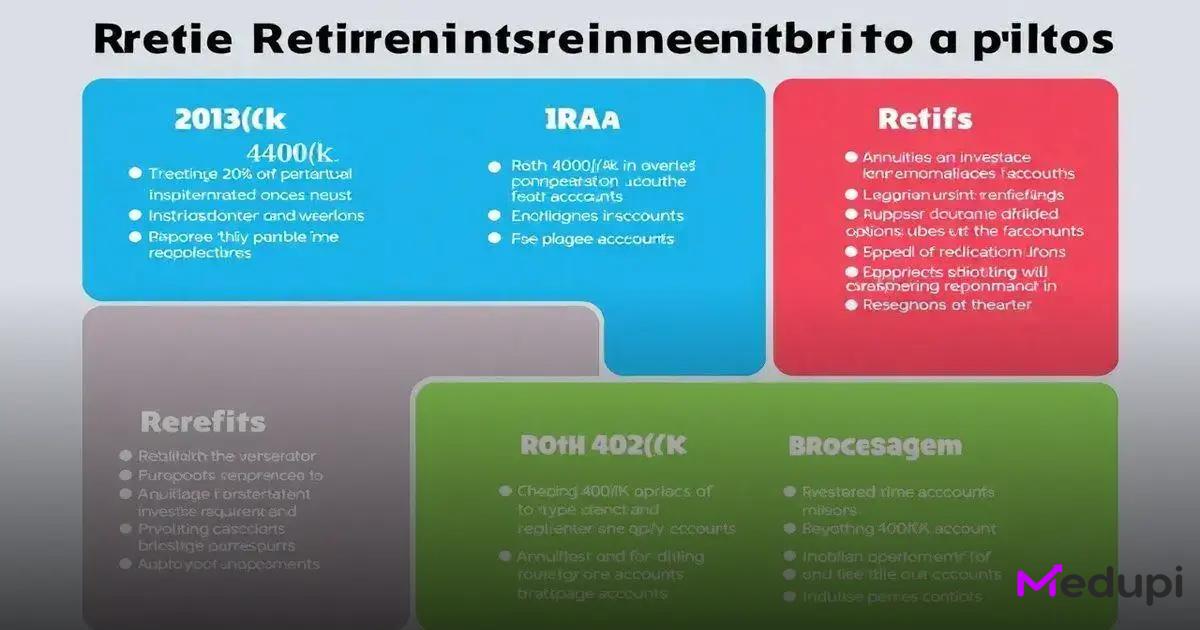ADVERTISEMENT
Retirement investment plans are essential for securing long-term financial stability. Planning early and making informed decisions can help build a solid foundation for a comfortable retirement. With options like 401(k)s, IRAs, and annuities, individuals have various ways to grow their wealth and ensure a steady income in their later years.
Choosing the right plan requires careful consideration of financial goals, risk tolerance, and tax implications. Understanding how each investment option works allows for smarter decisions that align with personal and financial objectives. Avoiding common mistakes, such as delaying contributions, ignoring employer matching programs, and failing to diversify, is key to maximizing returns.
ADVERTISEMENT
A well-structured retirement investment plan can make a significant difference in financial well-being during your golden years. Keep reading to explore the best strategies, investment options, and expert tips to help you secure a stable and worry-free retirement.
Understanding Retirement Investment Plans
Understanding Retirement Investment Plans is the first step towards achieving a secure financial future. These plans are designed to help individuals save money for their retirement years, ensuring that they have enough funds to support their lifestyle after they stop working.
ADVERTISEMENT
What Are Retirement Investment Plans?
Retirement investment plans encompass various financial products that allow individuals to invest their money for long-term growth. These plans typically involve setting aside a portion of your income over time to build a sizeable nest egg.
How Do They Work?
The funds invested in retirement plans can grow through interest, dividends, and capital gains. Many plans offer tax advantages, which means you can potentially save money on taxes as your investment grows.
Importance of Starting Early
It’s crucial to start investing in retirement plans as early as possible. The earlier you begin, the more time your money has to grow through the power of compound interest. Even small contributions can accumulate dramatically over the years.
Employer vs. Personal Retirement Plans
Some individuals may have access to employer-sponsored plans, such as 401(k)s, which often include matching contributions. Personal retirement accounts, like IRAs, provide alternative options for those without access to employer plans. Consider contributing to both for an optimal savings strategy.
Key Considerations
When choosing a retirement investment plan, think about factors such as your risk tolerance, investment horizon, and financial goals. Each plan has its benefits and limitations, so it’s important to evaluate what will work best for your unique situation.
Types of Retirement Investment Options

There are several types of retirement investment options available to help you save for your future. Each option comes with its unique features and benefits, allowing individuals to choose based on their financial goals and risk tolerance.
1. 401(k) Plans
A 401(k) plan is a company-sponsored retirement plan that allows employees to save a portion of their paycheck before taxes are taken out. Many employers offer matching contributions to encourage saving, which can significantly increase your retirement fund.
2. Individual Retirement Accounts (IRAs)
IRAs are personal accounts that you can open independently of your employer. Traditional IRAs may provide tax advantages, allowing your money to grow tax-deferred until you withdraw it in retirement. Roth IRAs are funded with after-tax money and allow for tax-free withdrawals in retirement.
3. Roth 401(k)
Similar to a traditional 401(k), the Roth 401(k) is funded with after-tax dollars. This means that while you won’t get a tax break when you contribute, your withdrawals in retirement are tax-free. This option can be beneficial if you expect to be in a higher tax bracket when you retire.
4. Annuities
Annuities are contracts with insurance companies that provide regular payments in exchange for an upfront investment. They can be fixed, variable, or indexed, depending on your preferences. Annuities can provide a stable income stream during retirement.
5. Brokerage Accounts
Brokerage accounts are not retirement-specific but can be used for investing in stocks, bonds, and mutual funds. While these accounts do not offer the same tax benefits, they provide flexibility and the potential for higher returns. This option requires active management of your investments.
Choosing the Right Option
When selecting your retirement investment options, consider your financial situation, investment goals, and risk tolerance. A mix of different options can help create a balanced portfolio to maximize growth while managing risk.
Benefits of Retirement Investment Plans
The benefits of retirement investment plans are numerous and essential for anyone looking to secure their financial future. By understanding these advantages, you can make informed choices that align with your retirement goals.
1. Financial Security
One of the primary benefits of retirement investment plans is the financial security they provide. These plans help you accumulate a significant amount of money over time, ensuring that you have the funds needed to live comfortably during retirement.
2. Tax Advantages
Many retirement investment plans offer tax benefits. For instance, contributions to a 401(k) or a traditional IRA can reduce your taxable income, allowing you to save more money each year. Additionally, the growth of your investments is often tax-deferred until withdrawal.
3. Compounding Growth
Retirement investments can grow significantly through the power of compounding. The earlier you start investing, the more your money can earn interest on both the initial investment and the interest already accumulated, leading to exponential growth over time.
4. Employer Contributions
Many employers offer matching contributions for their employees’ retirement plans. This means that for every dollar you contribute, your employer may add a certain amount, effectively providing you with free money toward your retirement savings.
5. Diversification Options
Retirement investment plans often allow you to diversify your investments across various asset classes, such as stocks, bonds, and mutual funds. A diversified portfolio can help reduce risk and improve your overall investment performance, leading to better potential returns.
6. Peace of Mind
Having a solid retirement investment plan in place provides peace of mind. Knowing that you are taking steps to secure your future allows you to focus on enjoying your current life without constantly worrying about how you will manage financially in retirement.
How to Choose the Right Retirement Plan

Choosing the right retirement plan is crucial for ensuring a secure financial future. Here are some detailed steps to help you make the best decision.
1. Assess Your Financial Goals
Before choosing a retirement plan, take time to assess your financial goals. Consider what kind of lifestyle you want in retirement and how much money you will need to support that lifestyle. Setting clear goals will guide your choice of plan.
2. Understand Your Options
Familiarize yourself with the different types of retirement plans available, such as 401(k)s, IRAs, and Roth IRAs. Each option has its advantages and disadvantages, so understanding these can help you select a plan that aligns with your goals.
3. Evaluate Your Risk Tolerance
Everyone has a different risk tolerance, which is how much risk you are willing to take with your investments. Younger individuals may prefer higher-risk investments for growth potential, while those closer to retirement may lean towards safer options. Knowing your risk tolerance helps in selecting investments within your retirement plan.
4. Consider Tax Implications
Tax implications can vary significantly between different retirement plans. Some plans offer tax-deferred growth, while others may provide tax-free withdrawals in retirement. Understanding these tax advantages will help you choose a plan that fits your financial situation.
5. Evaluate Employer Contributions
If your employer offers a retirement plan with matching contributions, consider how much they will match. This can significantly boost your retirement savings. Always aim to contribute at least enough to receive the full employer match if available.
6. Seek Professional Advice
If you’re uncertain about which retirement plan is right for you, consider seeking advice from a financial advisor. They can provide valuable insights based on your personal financial situation and help you create a solid retirement strategy.
Common Mistakes to Avoid with Retirement Investments
Avoiding mistakes with retirement investments is crucial for a secure financial future. Here are some common pitfalls to watch out for.
1. Not Starting Early
One of the biggest mistakes people make is delaying their retirement savings. The earlier you start investing, the more time your money has to grow through compound interest. It’s essential to make savings a priority from the start of your career.
2. Ignoring Employer Match
Many employers offer matching contributions to retirement plans like 401(k)s. Failing to contribute enough to get the full match is like leaving free money on the table. Always aim to contribute enough to maximize your employer’s match.
3. Underestimating Your Retirement Needs
Some individuals underestimate how much money they will need in retirement. It’s important to calculate your expected expenses and aim for a retirement income that covers those costs. This includes healthcare, housing, and lifestyle expenses.
4. Lack of Diversification
Investing all your funds in one type of asset can be risky. It’s wise to diversify your investments across different asset classes, such as stocks, bonds, and mutual funds. This strategy can reduce risk and improve your potential for return.
5. Making Emotional Decisions
Allowing emotions to dictate your investment choices can lead to poor decisions. Sticking to a well-thought-out investment strategy is crucial, even during market fluctuations. Consider a long-term view rather than reacting impulsively to short-term market changes.
6. Neglecting Regular Reviews
Retirement investments should not be a set-it-and-forget-it process. Regularly review your portfolio to ensure it aligns with your goals and risk tolerance. Adjustments may be needed as you approach retirement age or as your financial situation changes.
Check out our article on Financial Markets to understand how they work and their role in the global economy.





